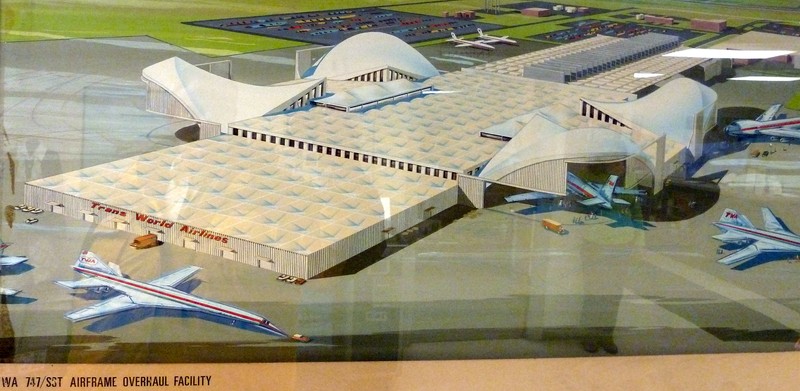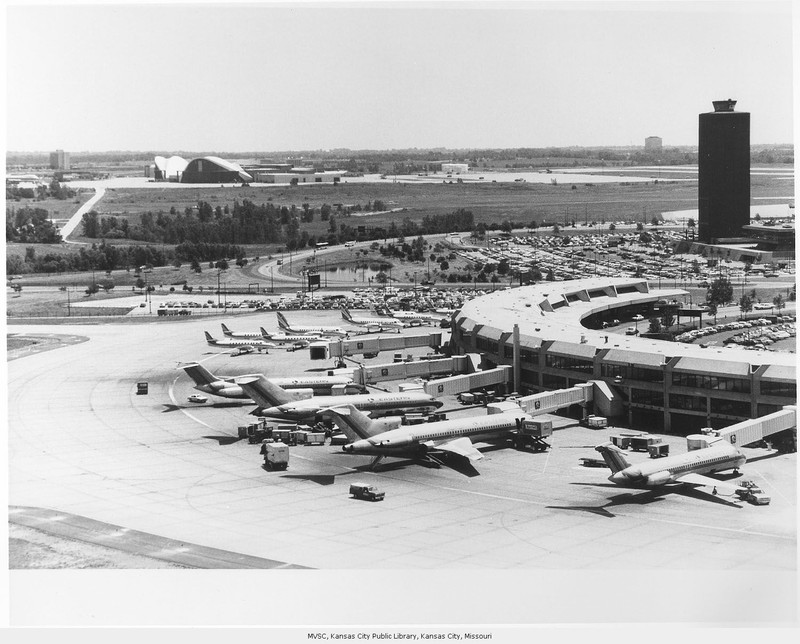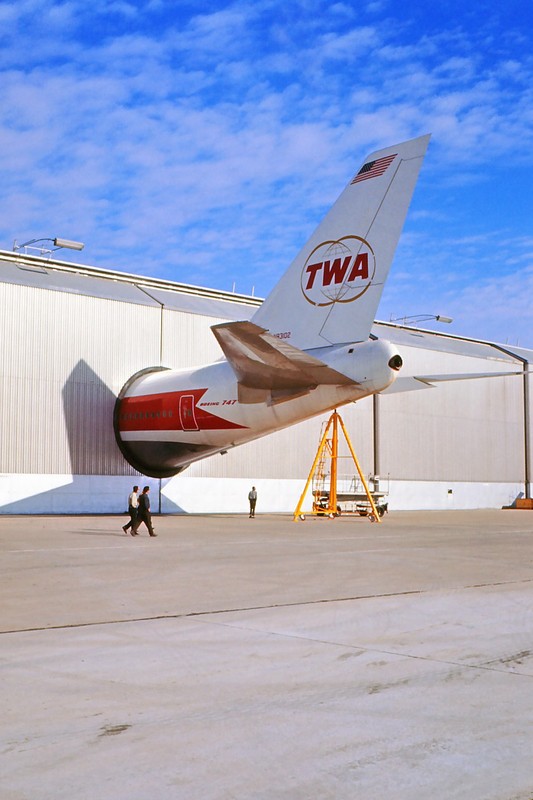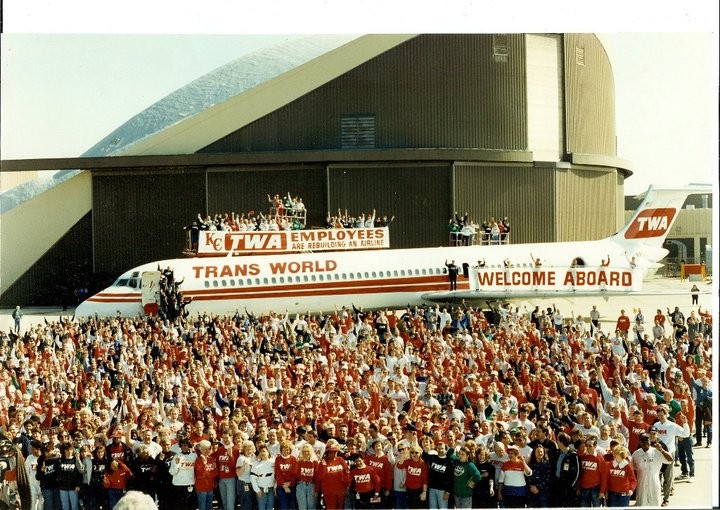TWA Overhaul Base - KCI Airport
Introduction
Author-Uploaded Audio
00:00 / 00:00
TWA Museum Director Donald Lueke describes the TWA Overhaul Base, an integral part of KC's aviation history
Text-to-speech Audio
Trans World Airlines’ enormous overhaul base at Kansas City International Airport was one of the largest airline maintenance facilities in the U.S. and is partly responsible for the current location of KCI. At its peak, the base handled repairs for additional airlines and even government aviation. The site became part of American Airlines’ maintenance facilities following TWA’s bankruptcy and sale to American in 2001, and operated for almost another decade before American closed the building in 2010. The facility enjoyed new life as Aviation Technical Services expanded there in 2014, where they can service up to 12 aircraft at once inside their hangars.
Images
Rendering of TWA's Overhaul Base

KCI's Terminal A with TWA Overhaul Base in background - photo courtesy of Missouri Valley Special Collections, Kansas City Public Library

Tail of 747 at Overhaul Base - photo courtesy of TWA Museum

Fundraiser at Overhaul Base, April 20,1993 - photo courtesy of John D. Larimer

This box was created for one of the first female mechanics at the overhaul base and was later signed by her during a visit to the TWA Museum in Kansas City

Backstory and Context
Author-Uploaded Audio
00:00 / 00:00
TWA Museum's Donald Lueke tells the story of a special wooden box with surprising ties to the TWA Overhaul Base
Text-to-speech Audio
TWA’s first overhaul base was at Kansas City’s downtown Municipal Airport (now named Charles B. Wheeler Airport and the home of the TWA Museum). In 1945, immediately following World War II, TWA moved its overhaul operations to Fairfax Airport across the Missouri River from Municipal, where B-25 bombers had been manufactured during the war.
In 1951, a catastrophic flood damaged both Municipal and Fairfax Airports, but destroyed the overhaul facility, and TWA began to look for a location away from the river. Kansas City aviation officials also began searching for a larger airport site and opened MCI (Mid-Continent Airport) on May 3, 1953 at KCI’s current location. Hoping to keep its hometown airline happy, Kansas City negotiated with TWA to move its overhaul operations to MCI, where they leased 250 acres of the 4,950-acre airport site. In the fall of 1954, after inking a deal with TWA, significant upgrades to MCI began, including two new runways and the first control tower at the airport. The new facility opened in 1957.
At its peak, TWA’s overhaul base employed 6,000 people, including many highly-skilled aviation technicians, and was Kansas City’s largest employer. This influence allowed TWA to lobby the city to expand Mid-Continent to accommodate TWA’s increasing commercial jet traffic, which was being squeezed by insufficient space at Municipal Airport. In 1966 following the passage of a $150-million bond, construction began on an innovative three-terminal design which allowed passengers to drive directly to their gate. Kansas City International Airport opened in 1972.
TWA’s financial troubles in the 1980s led to the airline’s takeover by investor Carl Icahn, who sold many assets in his quest for profits. In particular, the sale of TWA’s valuable London routes in 1991 caused the airline to file for bankruptcy in 1992. A second bankruptcy in 1995 and subsequent sale to American Airlines in 2001 brought the TWA overhaul base into the American Airlines portfolio, where it continued to operate until 2010, when American shuttered the facility. The base’s one million square feet of space went unused for four years, until Aviation Technical Services acquired the building, where they continue a long tradition of aviation maintenance, and have even worked like TWA with KCI Airport, to repave the runway.
Cite This Entry
Allen, Brandon and Clio Admin. "TWA Overhaul Base - KCI Airport." Clio: Your Guide to History. October 21, 2024. Accessed March 27, 2025. https://theclio.com/tour/2718/13
Sources
"American Airlines Closes Former TWA base in Kansas City", AviationPros.com. September 27th, 2010. Accessed August 2nd, 2024. https://www.aviationpros.com/home/press-release/10393438/american-airlines-closes-former-twa-base-in-kansas-city.
"ATS Kansas City", Aviation Technical Services. Accessed August 2nd, 2024. https://www.atsmro.com/about/locations/kansas-city-missouri/.
D'Onfro , Jillian. "Marc Andreessen: Carl Icahn Killed An Entire Airline", Business Insider. March 18th, 2014. Accessed August 2nd, 2024. https://www.businessinsider.com/marc-andreessen-carl-icahn-killed-an-entire-airline-2014-3.
"Fairfax Airport", B-25History.org. Accessed August 2nd, 2024. https://b-25history.org/history/airport.htm.
Morris, Frank. "Kansas City’s Enormous Airline Overhaul Base Full Again", KCUR.org (NPR in Kansas City). January 31st, 2014. Accessed August 2nd, 2024. https://www.kcur.org/economy/2014-01-31/kansas-citys-enormous-airline-overhaul-base-full-again.
"Trans World Airlines", AirportProjects.net. Accessed August 2nd, 2024. https://www.airportprojects.net/historickci/twa/.
https://www.flickr.com/photos/americasroof/5511555306
https://kchistory.org/image/kansas-city-international-airport-10?solr_nav%5Bid%5D=be4257a4d40500f7c839&solr_nav%5Bpage%5D=0&solr_nav%5Boffset%5D=7
https://www.facebook.com/photo/?fbid=1992749257495591&set=a.364024950368038
https://www.facebook.com/media/set/?set=a.10150092098967917&type=3
Photo by David Trowbridge

